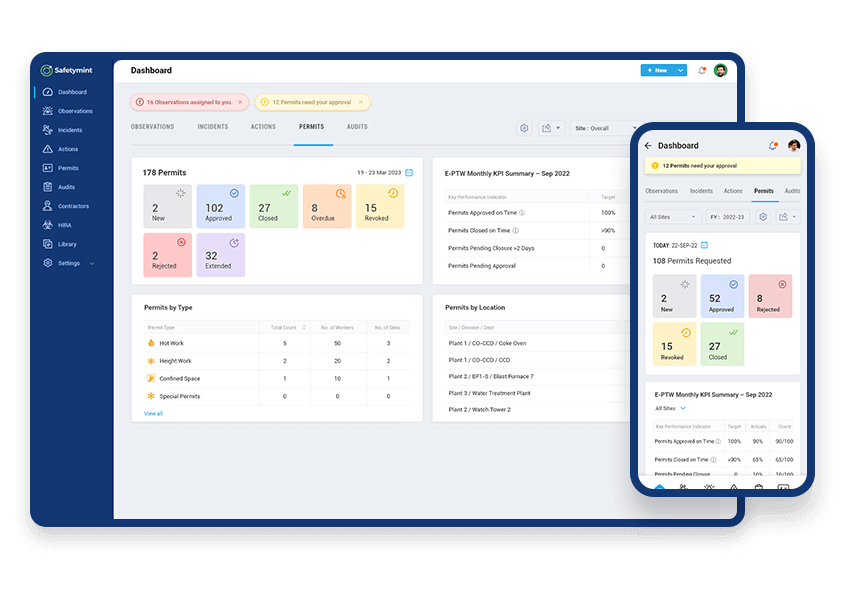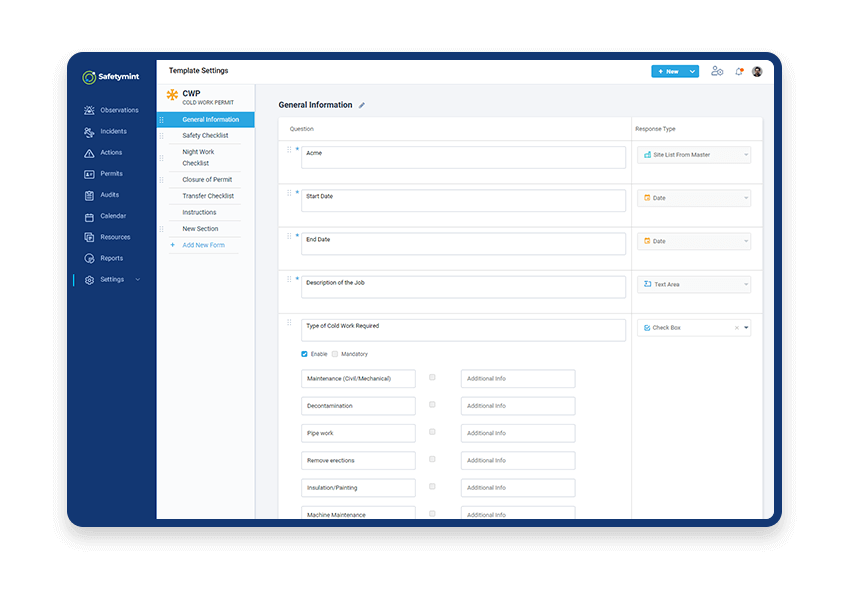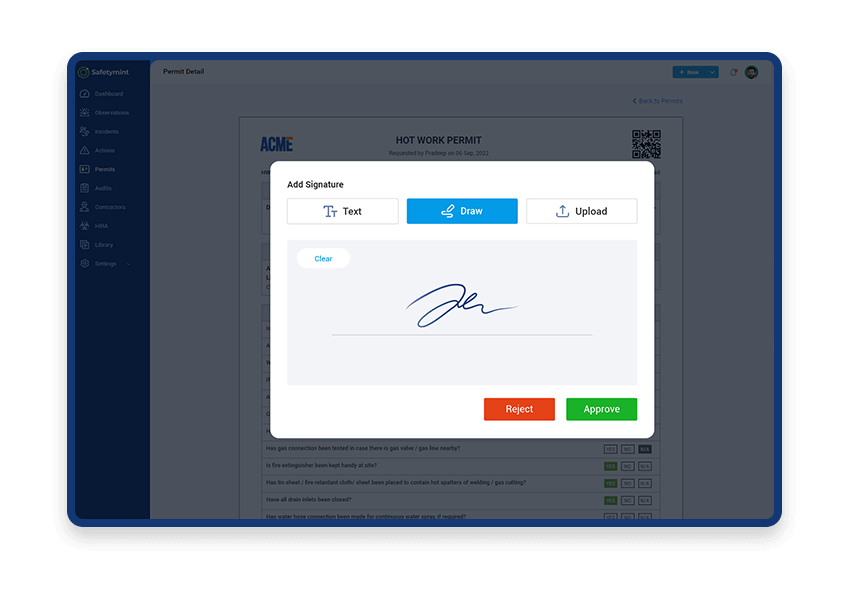Top-rated Control of Work Systems for Businesses
Managing Control of Work processes effectively is critical for maintaining operational safety and efficiency. The right software streamlines the complexities of this field, ensuring compliance and minimizing risks. In this detailed guide, we present the top 9 Control of Work software solutions of 2025. These tools excel in enhancing safety standards, managing permits, and streamlining work processes, making them indispensable for organizations striving for operational excellence.
Top 9 best Control of Work software:

Why use Safetymint:
Safetymint's Control of Work software is designed to streamline and elevate workplace safety by offering comprehensive digital solutions for permit management. By digitizing the entire permit-to-work process, Safetymint brings efficiency and clarity to managing work permits. The software is an essential tool for organizations aiming to reduce administrative overhead while enhancing safety protocols. Its intuitive interface ensures that all personnel, from safety officers to contractors, can easily navigate the system and stay informed about the status of permits in real-time.
Safetymint is built to manage complex workflows associated with hazardous work permits, allowing seamless collaboration across teams. It helps identify potential risks before work begins, ensuring that safety standards are maintained. With its real-time insights and customizable dashboards, Safetymint enables safety officers to track permit statuses, anticipate potential conflicts, and ensure compliance with regulatory requirements. This results in smoother operations, reduced delays, and enhanced safety standards across all projects.
Take a free trial Schedule a DemoKey features of Safetymint:
- Digital Permit Management: Allows easy creation, tracking, and management of work permits.
- Risk Assessment: Assesses risks associated with each permit, ensuring potential hazards are minimized.
- Lockout-Tagout: Simplifies the management of lockout-tagout procedures to ensure equipment is safely isolated.
- Isolation Management: Centralizes isolation planning and tracking, ensuring safe and compliant operations.
- Contractor Management: Manages contractor information and activities, ensuring they meet safety standards.
- Workflow Automation: Streamlines approval processes, reducing delays and improving efficiency.
- Real-Time Monitoring: Provides up-to-date insights into permit statuses and safety compliance.
- Customizable Dashboards: Offers personalized dashboards for quick access to critical information.
- Collaborative Tools: Facilitates seamless communication across teams for efficient workflow.
"Safetymint's remarkable flexibility, lightning-fast implementation, and system adaptability to our project's needs were invaluable during the development of our solution."
Test & Commissioning Manager
World-leading Transportation Management Company


Why use Enablon:
Enablon's Control of Work software is a comprehensive solution designed to enhance operational safety, efficiency, and compliance across various high-risk industries such as mining and energy. It emphasizes reducing risks, improving safety protocols, and ensuring adherence to environmental and safety regulations. The software is designed to streamline critical maintenance tasks during daily operations, preventing unplanned shutdowns and fostering a safer work environment. With features like integrated permit-to-work systems, risk assessments, and isolation management, Enablon's CoW solution provide dynamic barrier health views to prevent catastrophic incidents that could harm people and the environment.
Key Features:
- Integrated Permit to Work: Manages permits directly from the system, ensuring compliance.
- Risk Assessment: Assesses and mitigates risks across all business operations.
- Isolation Management: Automates the isolation plan creation for better process control.
- Dynamic BowTie Analysis: Offers real-time insights into hazards and barriers.
- Field Operations Management: Enhances productivity with shift and crew handover management.
- Shutdown & Turnaround Planning: Prepares permits and isolation plans for shutdowns.
- Simultaneous Operations Management: Provides predictive risk analysis for hazardous work.
- Barrier Management: Monitors the effectiveness of control measures.
- Process Safety Management: Empowers effective safety management for engineers and managers.
- Compliance Assurance: Ensures adherence to regulatory standards and reduces operational risks.

Why use Sphera:
Sphera's Control of Work software is a robust solution designed to streamline operational safety and efficiency across various industries, including energy, mining, and pipelines. It integrates key features such as electronic Permit to Work, isolation management, dynamic risk pathways, and barrier management into a single platform to provide a comprehensive view of operational risk in real time. This approach helps organizations standardize work practices, ensuring safety and efficiency, while enabling proactive management of potential risks. The software's dynamic risk pathways and digital twin capabilities allow users to visualize the impact of hazardous events on their assets, ensuring informed decision-making and better risk prioritization.
Key Features:
- Permit to Work: Offers a streamlined permit process, providing a holistic view of all activities to improve safety.
- Isolation Management: Enables efficient isolation plan creation for different stages of work to prevent uncontrolled energy releases.
- Dynamic Risk Pathways: Simulates real-time causal pathways related to specific risk scenarios.
- Process Safety Barrier Management: Visualizes deviations and hazardous activities to mitigate risk impact.
- Operations Logbook & Shift Handover: Prepares teams for efficient shift transitions by summarizing key activities and risks.
- Emergency Preparedness & Response: Ensures teams have quick access to response plans during emergencies.
- Integrated Visualization: Provides real-time visual insights into operations to optimize scheduling and safety.
- Predictive Analytics: Offers advanced analytics to support proactive decision-making and risk management.
- Mobile Solutions: Allows access to critical information on the go for timely interventions.

Why use Quentic
Quentic's Control of Work software is an integrated solution that helps businesses enhance safety, compliance, and operational efficiency. Tailored to unify EHSQ management with business operations, it streamlines the entire process of planning, executing, and overseeing work activities to ensure high safety standards and operational smoothness. The platform provides digital permit-to-work functionality, which simplifies the management of hazardous work involving chemicals, high voltage, or fall risks, thereby ensuring comprehensive and accurate documentation of safety measures. This digital transition helps eliminate paperwork, making the approval process faster and more transparent. The Management of Change module is particularly beneficial in guiding organizations through transitions efficiently, breaking down implementation into actionable steps.
Key Features
- Permit to Work: Streamlines the issuance and management of permits for high-risk activities.
- Management of Change: Guides organizations through changes, ensuring efficient implementation.
- Digital Documentation: Eliminates paperwork, enabling fast and transparent approval processes.
- Seamless Workflows: Ensures smooth collaboration among all stakeholders in planning and safety measures.
- Hazard Management: Helps manage and mitigate risks related to hazardous chemicals and high-voltage equipment.
- Incident Management: Supports efficient handling of incidents and accidents.
- Legal Compliance: Helps identify legal obligations and fulfill compliance requirements.
- Health & Safety Management: Ensures compliance with health and safety regulations and improves working conditions.
- Centralized Database: Provides a unified platform for all data related to safety and compliance.
- Mobile Reporting: Enables quick and easy reporting of forms and checklists from anywhere.

Why use VelocityEHS:
VelocityEHS's Control of Work software provides a comprehensive solution designed to help businesses streamline operational safety and compliance. The software includes various features, such as electronic Permit to Work, contractor management, and visitor management, allowing companies to maintain high safety standards and enhance operational efficiency. The platform enables centralized permit management, allowing organizations to organize permits digitally, conduct qualification checks, and ensure 100% compliance for contractors and employees. It provides comprehensive dashboards and reports, ensuring transparency across all levels of the organization.
Key Features:
- Electronic Permit to Work: Simplifies the permit-to-work process with digital management of permits.
- Contractor Management: Ensures proper vetting and approval of contractors before they enter a worksite.
- Contractor Self-Service Portal: Allows contractors to manage their own details and permits.
- Qualification Management: Centralizes the management of contractor and employee qualifications.
- Visitor Management: Tracks visitor statuses to ensure compliance.
- Induction & Orientation: Facilitates induction and training for new contractors.
- Dashboards & Reports: Provides comprehensive reports and dashboards for enhanced transparency.

Why use GOARC:
GOARC's Control of Work software provides a dynamic solution for managing safety programs and connected workers in industrial environments. The software aggregates data from ERP systems, OT, and IoT sensors to offer a comprehensive platform that unifies different sources of information. It includes tools like dynamic permit-to-work workflows, which help optimize risk assessment and productivity by combining permit applications with AI-driven insights into a single system. The platform provides real-time data to analyze processes and monitor KPIs, enabling proactive management of potential safety risks. Other features include shift management and lockout-tagout capabilities, ensuring seamless integration of safety protocols across the facility.
Key Features:
- Dynamic Permit-to-Work Workflows: Combines permit applications and AI-driven risk assessment to streamline the workflow, enhancing productivity and reducing risk.
- Shift Management: Offers data-driven handover tools with real-time connectivity, visibility, and communication for seamless shift transitions.
- Lockout-Tagout (LOTO): Provides a flexible, holistic, digital solution for managing LOTO efficiently.
- Centralized Command Center: Aggregates data for accurate, visual insights that help identify risks, gaps, and failures.
- Gamification Management: Encourages safe behavior and engagement through motivational tools and accurate reporting.
- Customized Approval Workflows: Provides dynamic forms aligned with internal business policies for tailored approval processes.
- Comprehensive Data Analysis: Uses real-time data to optimize workflows, assess risks, and improve productivity.
- Proactive Safety Management: Supports incident investigation and corrective actions with advanced data insights.
- Visual Safety Mapping: Displays activities, applications, and hazards on the same map for all levels of the organization.

Why use Versify:
Versify’s Control of Work software offers a comprehensive suite designed to improve safety and operational efficiency across various industries. The software includes features like digital work permits and shift management that streamline the work process and enhance compliance. Its intuitive design integrates seamlessly with existing workflows, allowing users to efficiently manage work permits, identify risks, and track operations in real time. The software’s robust data analysis capabilities provide valuable insights for better decision-making and enable businesses to minimize risks and maximize productivity.
Key Features:
- Digital Work Permits: Simplifies the management and tracking of permits for increased efficiency.
- Shift Management: Facilitates seamless shift handovers with improved communication and connectivity.
- Risk Assessment: Offers comprehensive tools to identify, evaluate, and mitigate risks in real time.
- Operational Insights: Provides detailed analytics for better decision-making and enhanced compliance.
- Customizable Workflows: Adapts to specific business needs to optimize operations and ensure compliance.
- Comprehensive Reporting: Delivers actionable insights with customizable reports and dashboards.

Why use Aveva:
Aveva's Operational Safety Management software offers a comprehensive solution for managing safety and operational processes. It integrates seamlessly with existing systems to provide real-time visibility into safety procedures, ensuring compliance and reducing risks. The software's intuitive design enables users to easily manage permits, monitor activities, and implement safety protocols across all operations. By providing actionable insights and facilitating communication between teams, it ensures that all safety-related activities are tracked and executed efficiently, minimizing the potential for incidents and enhancing overall productivity.
Key Features:
- Permit-to-Work Management: Streamlines the permit approval process and ensures compliance.
- Real-Time Monitoring: Offers real-time insights into safety activities to enhance decision-making.
- Compliance Tracking: Tracks adherence to safety protocols and regulatory requirements.
- Risk Assessment: Identifies and evaluates risks to minimize potential incidents.
- Workflow Automation: Automates key workflows to optimize efficiency and compliance.
- Operational Insights: Provides comprehensive analytics for better decision-making and risk management.
- Incident Management: Facilitates rapid response and resolution of safety incidents.
- Collaboration Tools: Enhances team communication and ensures smooth workflow coordination.

Why use RelyOnNutec:
RelyOnNutec's Control of Work system provides an advanced solution to streamline safety and compliance in operational processes. The software focuses on enabling better risk assessment, ensuring proper permit management, and improving the overall safety culture within organizations. By integrating digital tools for permit-to-work systems, shift handovers, and risk assessment, it offers comprehensive visibility and control over safety-critical activities. This software facilitates better coordination among teams and ensures that all safety protocols are adhered to, minimizing the risk of incidents while maximizing productivity.
Features:
- Digital Permit Management: Streamlines the process of issuing and tracking permits to ensure compliance.
- Risk Assessment: Identifies and assesses risks in real-time to minimize hazards.
- Shift Handover Management: Ensures smooth transitions with seamless communication and tracking.
- Workflow Automation: Automates workflows for increased efficiency and compliance.
- Incident Management: Enables rapid response to safety incidents for quick resolution.
- Reporting and Analytics: Offers comprehensive insights for data-driven decision-making.
- Collaboration Tools: Enhances communication and coordination across teams.
An introduction to Control of Work System:
What is a Control of Work System?In industries like oil and gas, chemical processing, manufacturing, and construction, workers often face risks from hazardous activities. A Control of Work system helps manage these risks by establishing a standardized way to plan, authorize, and control high-risk work.
Think of it as a set of rules and procedures that ensure everyone is on the same page before any potentially dangerous job starts. It's like having a safety checklist that identifies hazards, evaluates risks, and implements control measures to protect workers, assets, and the environment.
The importance of Control of Work software:Accidents can happen without proper controls in place. A Control of Work system helps prevent incidents by ensuring:
- All risks are identified and evaluated before work begins.
- Appropriate safety measures are implemented, such as permits, isolations, and protective equipment.
- Clear communication and coordination between teams, contractors, and stakeholders.
- Compliance with relevant regulations and industry standards.
By following a structured Control of Work process, organizations can minimize risks, improve safety performance, and avoid costly accidents, downtime, and legal consequences.
Whether you're working with hazardous materials, confined spaces, or at heights, a robust Control of Work system is essential for maintaining a safe and efficient workplace.
Key Components of a Control of Work System
A robust Control of Work system typically comprises several essential components that work together to identify, evaluate, and mitigate risks associated with potentially hazardous work activities.
1. Risk Assessment:Risk assessment is the first step in any Control of Work process. It involves identifying potential hazards associated with a job and evaluating the likelihood and severity of those risks. This could include hazards like working at heights, exposure to chemicals, or working in confined spaces. The goal is to understand the risks before starting work and implement appropriate control measures.
2. Permit to Work:For high-risk activities, a Permit to Work is often required. This document authorizes the job and outlines specific safety requirements, such as isolations, personal protective equipment (PPE), and emergency procedures. It's like a contract between the worker and the organization, ensuring everyone understands and follows the necessary precautions.
3. Job Safety Analysis (JSA) or Job Hazard Analysis (JHA):A JSA or JHA is a detailed examination of each step in a job, identifying the potential hazards and control measures for each task. It's like breaking down a job into smaller pieces and putting a safety plan in place for every step. This helps workers stay vigilant and prepared for any risks that may arise.
4. Isolation and Lockout/Tagout (LOTO):When working with equipment or systems that contain hazardous energy sources (like electricity, hydraulics, or stored energy), isolation and LOTO procedures are crucial. Isolation ensures that all energy sources are safely disconnected, while LOTO prevents the accidental restart or release of energy during maintenance or repair work.
In addition to these key elements, a comprehensive Control of Work system often includes the following features:
Permit Checklists and Templates: Pre-defined permit checklists and templates help streamline the permit application process, ensuring all necessary information is captured consistently and accurately.
Contractor Management: Features for managing contractor information, qualifications, and performance help ensure that third-party workers adhere to the organization's safety standards and requirements.
Safety Audits and Inspections: Regular audits and site inspections verify that work is being conducted in compliance with safety protocols, allowing for timely identification and correction of any deviations.
Shift Management: Effective shift management tools ensure proper handover communication and continuity of safety protocols across different work shifts or crews.
Scheduling: Integrated scheduling tools coordinate and optimize the timing of various work activities, avoiding conflicts and ensuring proper resource allocation for safe and efficient operations.
Benefits of a Control of Work Software
Implementing a dedicated Control of Work software solution offers numerous advantages that can significantly enhance an organization's ability to manage risks, ensure compliance, and maintain a safe and efficient work environment.
1. Centralized Management:With a Control of Work software, you can manage all your work activities, permits, and associated documentation in one centralized system. No more scattered paperwork or miscommunication – everything is organized and accessible from a single location, making it easier to track and coordinate work across different teams and sites.
2. Standardized Processes:The software ensures that your Control of Work procedures are consistently followed across the organization. Whether it's risk assessments, permit approvals, or safety checklists, everyone is on the same page, minimizing the risk of errors or deviations from established protocols.
3. Improved Communication:Effective communication is key to a successful Control of Work system. The software facilitates seamless information sharing among teams, contractors, and stakeholders. Real-time updates, notifications, and access to relevant documents keep everyone in the loop, reducing the chances of miscommunication or missed information.
4. Compliance and Auditing:Maintaining compliance with industry regulations and internal policies can be a daunting task, but a Control of Work software simplifies the process. It helps you track and demonstrate compliance with safety standards, making audits and inspections a breeze by providing comprehensive documentation and audit trails.
5. Risk Mitigation:Ultimately, the goal of a Control of Work system is to mitigate risks associated with hazardous work activities. With the software's risk assessment tools, permit management, and safety checks, you can identify and address potential hazards proactively, reducing the likelihood of incidents, accidents, and costly downtime.
Try Safetymint
XDigitize your Control of Work with Safetymint. Take a 14-day free trial.
Get started with a 14-day free trial.
Take a free trialGet started with a 14-day free trial.
Get access to all the modules. No credit card needed.







